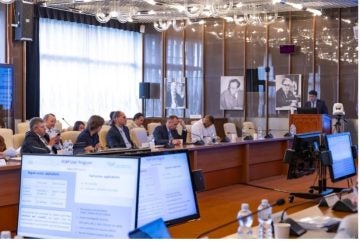
Rosatom and the Joint Institute of Nuclear Research (JINR or OIYaI – Obedinionnii Institut Yadernikh Issledovanii) in Dubna (Moscos region) signed an agreement on cooperation on the sidelines of the II International Youth Nuclear Forum Obninsk NEW.
Among the key areas are the development, creation and modernisation of nuclear technologies, conducting scientific research, creation and operation of a modern experimental bench base and research infrastructure.
Among the key areas are the development, creation and modernisation of nuclear technologies, conducting scientific research, creation and operation of a modern experimental bench base and research infrastructure.
The parties will work together on the superconducting collider of the NICA Accelerator Complex (Nuclotron-based Ion Collider fAcility) and ensure the operation of JINR’s IBR-2M research reactor. An agreement was also signed on JINR’s accession to the International Consortium based on the MBIR reactor under construction at the Research Institute of Atomic Reactors (NIIAR) in Dimitrovgrad.
I am confident that, in cooperation with the JINR, we will be able to significantly expand the research base for applying the experimental capabilities of MBIR and strengthen the associated international research centre,” said Rosatom Director General Alexey Likhachev. This global international platform will not only unite the world scientific community, but will also allow Russia to provide leadership in the development of innovative reactor technologies.”
The 150 MWt multi-purpose sodium-cooled fast neutron reactor will be the world’s largest facility of its kind. It will replace the BOR-60 experimental fast reactor that has been in operation at NIIAR since 1969 and is due to close in 2025. MBIR will be used for materials testing for Generation IV fast neutron reactors. It will be capable of testing lead, lead-bismuth and gas coolants and will enable reactor and post-reactor experiments, perfecting technologies for the production of isotopes and modified materials.
JINR Director Academician Grigory Trubnikov said the institute is interested in using the extracted neutron beams from MBIR for scientific research. Currently, scientists from the AI Leipunsky Institute of Physics & Power Engineering (IPPE) in Obninsk and JINR are discussing possible designs of experimental installations on the horizontal experimental channels of MBIR.
“We count on Rosatom’s help in upgrading our basic nuclear installation – the IBR-2M reactor,” Trubnikov noted. He added that Rosatom’s help was also sought in creating infrastructure for studying the properties of superheavy elements; in the implementation of the NICA accelerator complex project; in the development and production of a cyclotron complex based on the superconducting cyclotron MSC-230 for proton radiation therapy; and in the creation of a new pulsed neutron source at the institute.
Meanwhile, the 59th session of JINR’s Programme Advisory Committee (PKK – Programmno Konsultivnovo Komiteta) held discussions on plans for the resumption of work at IBR-2 research facilities and the creation of a new source of neutrons. “Our plans for the launch of IBR-2 have not changed much – as planned, we expect to resume the operation at the end of this year, and we will be able to resume the user programme next year,” said the Director of the JINR Laboratory of Neutron Physics Yegor Lychagin.
Earlier in June Russian President of the Russian Federation Vladimir Putin had launched the NICA project signalling the beginning of preparations for the physics run of the complex, scheduled for late 2024 or early 2025. Testing is now underway of the power supplies of the collider’s superconducting magnets and the superconducting magnet of the first experimental facility of the complex, the Multi-Purpose Detector (MPD). The start of the technological run of the superconducting solenoid, the main unit of the MPD Facility, and the collider will pave the way for the launch of the entire NICA Complex.
JINR is an international intergovernmental scientific research organisation established in1956 by 11 founding member states and registered with the United Nations in 1957. JINR is situated in Dubna city, the Moscow Region, the Russian Federation. JINR is a unique scientific integrating fundamental theoretical and experimental research with development and application of the cutting-edge technology and university education. Currently it has 16 member states and five associate members. Full members include Armenia, Azerbaijan, Belarus, Bulgaria, Cuba, Egypt, Georgia, Kazakhstan, North Korea, Moldova, Mongolia, Romania, Russia, Slovakia, Uzbekistan, and Vietnam. Participation of associate members – Germany, Hungary, Italy, South Africa and Serbia – is based on bilateral agreements signed at the governmental level. North Korea’s membership was suspended in 2015 but is expected to be restored in the near future.






